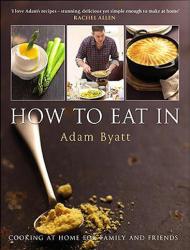 The first thing you should know about Adam Byatt’s ‘How to eat in’ is that the recipes are not as hard as they look.
The first thing you should know about Adam Byatt’s ‘How to eat in’ is that the recipes are not as hard as they look.
The basis of this rather hefty book are recipes to elevate simple home cooked meals to family favourites and recipes to serve as dinner party pièce de résistance. By simply flicking through the book and looking at the photographs though, it’s difficult not to imagine the amount of work it would take to recreate some of the dishes. The introduction for beetroot-cured salmon gravadlax even states that it’s a four-day process – not a job to be taken on unless you are a seriously keen cook.
As this is his first cookbook, chef and patron of Trinity in Clapham Adam Byatt has done very well. The dishes are not only beautifully presented but some are also highly unusual like the maple-glazed belly of pork with saffron and cockles. This makes a refreshing change to the cookbooks full of staples.He has divided up his book like a menu. There are the breads, the starters, the mains, the desserts and the sauces to complement. And given the selection of recipes and a special section on outdoor food, this book is something which can be used all year round.
Having previously dined at Trinity, I instinctively looked for the food served there. The recipes revealed all the hard work that went into those delicious meals and gave me a real appreciation of the flavours. They were also a little daunting because having already spotted the salmon gravadlax recipe, I thought that all the recipes were going to be quite complex and time consuming.
Take the pig’s trotters on toasted sourdough with crackling for example, it’s a staple on the Trinity menu. The recipe itself spreads over two pages. One page is solely dedicated to the list of ingredients and instructions for preparation, some of which must be done the day before. The second page is the actual method. If there wasn’t a deliciously tempting photograph intercepting the two pages, I would surely be going crossed-eyed at the amount of work. But then after actually reading through the recipe, there wasn’t anything particularly hard. Cooking the dish still takes a lot of time and effort but at least the result is rewarding.
There is a fair selection of easy but equally delicious recipes too like pot roast loin of old spot pork with kumquats or the 10-minute banana and maple ice cream.
Perhaps what has been most daunting all along has been Byatt’s chef-approach to his recipes. That is, every recipe comes with a comprehensive preparation guide so when you come to the method section, it’s literally a matter of cooking. For the trained chef, this comes as second nature. For the average Joe, though, it seems like a lot of work.
Overall, ‘how to eat in’ has been very inspiring. It serves as more of a guide to cooking restaurant quality food at home than a day-to-day cook book. But if you love to cook and you love good food, this book would be perfect.
{ISBN:059306464X}
